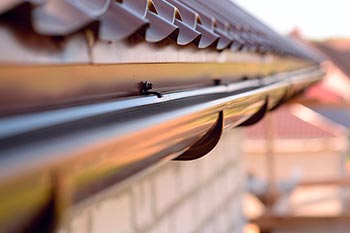Your home’s roof and gutter system are responsible for collecting and diverting water from your home and away from its foundation. When your gutters become clogged or damaged, they can cause water to fall from them to saturate the soil below, causing moisture to seep into your basement and foundation. For this reason, it is important to keep your home gutters working and maintained in tip-top shape. Here are three ways you can keep your roof gutter system draining well to prevent moisture leaks into your home’s basement and foundation.
1. Clean and Maintain Your Gutters
When rain falls upon your roof, any debris, such as leaves and twigs, can end up washing into your gutters. As this type of debris collects in your gutters, it will clog the flow of water and prevent rain runoff from draining down through your downspouts. A clogged downspout can cause runoff, especially in a heavy storm, to flow over the sides of the gutters and onto the soil below. Along with debris-filled gutters, cracks and holes in your gutters and their seams can cause runoff to drip to the soil below.
When rain falls from your gutters, the soil around your home’s foundation will quickly become saturated from the spillage, causing the moisture in the soil to flow the path of least resistance, through cracks in your foundation walls or through your home’s foundation slab. You need to keep your gutters cleaned out throughout the year. You can spray them out with a pressure washer or garden hose, or hire a gutter professional to clean and maintain them.
Experts tell you to clean debris from them at least twice a year; more if you have pine trees in your yard. If your gutters have become aged and are leaking along their seams, it may be time to replace them with seamless gutters, which do not have seams that can become worn and cracked with age. You can also install gutter screens over your roof gutters to prevent debris from falling into them.
2. Maintain Gutter Downspouts and Diverters
Once you have your gutters replaced or cleaned out to ensure proper water runoff, you should also check the downspouts for proper functioning. Downspouts should connect to the gutters without any cracks in their connections, as this can cause runoff to leak and fall to the soil below. If your downspout is showing cracking, holes, or has other damage, you need to talk to a gutter professional about replacing it.
Check to make sure that debris has not clogged your downspouts so that water can flow down and drain properly. A clog in your downspout can cause water to back up into the gutters. Clean out any downspout clogs with a sewer snake or talk to your gutter professionals about its cleaning.
And at the end of the downspout, you should connect a downspout diverter that is at least five feet in length, which delivers water away from your home. Position the end of the diverter onto concrete pavement or gravel, so the water draining from it does not erode the soil. If you don’t have access to a nearby paved surface, you can place a splash block at the end of your diverter to help prevent soil erosion.
3. Landscape Your Yard Appropriately
Along with diverting your gutter runoff away from your home’s foundation, you can landscape the soil around your foundation to help water flow away from your home instead of toward it. Build up the soil around your home so that it falls away from your home by at least six inches in the first ten feet. Building a slope to the soil that is greater than this and adding a covering to the soil, such as landscaping bark or gravel is even better for promoting water drainage from your basement and foundation.
With these tips, you can keep your home’s gutter and its drainage system working well and improve your home’s appearance. You will also benefit by keeping your basement free of moisture intrusion with a potential for mold and mildew growth after each rainstorm.

